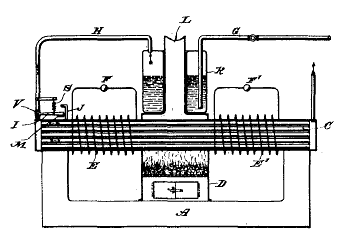Multiferroic Energy
July 11, 2011
Thermoelectric devices can produce an
electrical voltage from a
temerature difference via the
Seebeck effect, so they are used for
environmental energy-harvesting. There are problems in their application, since the most efficient
thermoelectric materials, like
bismuth telluride, are both
toxic and expensive.
There are quite a few ferro-materials in the wild, such as
ferroelectrics and
ferromagnets. These are materials that undergo a large change in a property at a critical temperature. In ferromagnets and ferroelectrics, this temperature is called the
Curie temperature, named after
Pierre Curie. Magnets lose their magnetism above the Curie temperature.
The study of these "ferro" materials has been called
ferroics. The name probably makes sense to the small number of people working on problems that involve more than just ferromagnets, or just ferroelectrics; but it's unlikely that the
IEEE Ultrasonics, Ferroelectrics & Frequency Control Society will change its name anytime soon.
Ferroics includes
multiferroics, materials that exhibit more than one ferroic property at the same time. Researchers at the
University of Minnesota have been investigating one such material, Ni
45Co
5Mn
40Sn
10, that undergoes a reversible
phase transformation from a non-magnetic
Martensitic phase to strongly ferromagnetic
austenitic phase when heated. The magnetization of the austenitic phase approaches that of
iron. I wrote about the (austenite
<--> Martensite) transformation in a
recent article (Flash Bainite, June 29, 2011).
The research team, led by
Richard James, professor of
aerospace engineering and mechanics, report on the direct conversion of
heat to
electricity by this material in the inaugural issue of
Advanced Energy Materials.[1-4] The mechanism is quite simple. They surround the material with a
coil of wire, and the abrupt presence of the magnetic field above the critical temperature induces an electrical voltage in the coil according to
Faraday's law of induction. In the demonstration device, the coil of 2000 turns of 0.13 mm diameter (36
AWG)
copper wire had an inner diameter of 1.9 cm and an outer diameter is 3.8 cm.
The devil, of course, is in the details, the first of which is that you need the presence of a nearby biasing magnet to align the
domains in the magnetic phase. Since the optimum geometry for the material is a long, slender rod, you're aided slightly by the
shape anisotropy, but you need to have your biasing field cover a considerable volume. The other point of finesse is the transition width. According to Faraday's law, you're converting a
rate of change of magnetic field to a voltage, so you won't get much voltage unless the entire body passes through the critical temperature quickly, and at the same time.
One thing that this material has in its favor is a reasonably low
hysteresis; so small, cyclic changes in temperature can be converted to a voltage. The hysteresis is low because the transformation is a
diffusionless transformation. Also, (austenite
<--> Martensite) transformations are very fast, close to the
speed of sound in the material. The transition temperature of the material is about 140°C, which is just below the Curie temperature of 167°C, but the magnetization, which decreases with temperature for ferromagnets, is still high at that temperature.
Such materials would be useful in most energy-harvesting applications only if the transition temperature is around
ambient, 20°C, so new materials need to be discovered. One possible application that the authors cite is extracting energy from the temperature difference between
ocean water and air. The paper claims
theoretical efficiencies at least as good as for thermoelectrics.
The Minnesota team is working with
Christopher Leighton, a professor of
chemical engineering and materials science, on thin film devices to convert waste heat from
computers into electricity. Research in energy-harvesting is truly
interdisciplinary. Team leader, Richard James, says "It includes engineering, physics, materials, chemistry, mathematics and more. It has required all of us within the university's College of Science and Engineering to work together to think in new ways."
Funding was provided by the
U.S. Office of Naval Research, the
U.S. Air Force and the
National Science Foundation.
One reference in the paper in Advanced Energy Materials is to an 1887 patent by
Nikola Tesla.[4] The first paragraph of which reads,
"Be it known that I, NIKOLA TESLA, a subject of the Emperor of Austria-Hungary, from Smiljan, Lika, border country of Austria-Hungary, residing in New York, in the county and State of New York, have invented certain new and useful Improvements in Electrical Generators..."

Sole figure of US Patent No. 428,057, "Pyromagneto-Electric Generator," by Nikola Tesla, May 13, 1890.
(See Reference 4.)
![]()
References:
- Rhonda Zurn, "University of Minnesota engineering researchers discover source for generating 'green' electricity," University of Minnesota Press Release, June 22, 2011.
- AEM Researchers Discover New Way to Convert Heat to Electricity, University of Minnesota Spotlight, March 28, 2011.
- V. Srivastava, Y. Song, K. Bhatti and R.D. James, "The Direct Conversion of Heat to Electricity Using Multiferroic Alloys," Advanced Energy Materials, vol. 1, no. 1 (January 1, 2011), pp. 97-104.
- Nikola Tesla, "Pyromagneto-Electric Generator," US Patent No. 428,057, May 13, 1890
Permanent Link to this article
Linked Keywords: Thermoelectric; electrical voltage; temerature; Seebeck effect; environmental energy-harvesting; thermoelectric materials; bismuth telluride; toxic; ferroelectric; ferromagnet; Curie temperature; Pierre Curie; ferroics; IEEE Ultrasonics, Ferroelectrics & Frequency Control Society; multiferroics; University of Minnesota; phase transformation; Martensitic; austenitic; iron; Richard James; aerospace engineering and mechanics; heat; electricity; Advanced Energy Materials; solenoid; Faraday's law of induction' American wire gauge; AWG; copper; The devil is in the details; domain; shape anisotropy; hysteresis; diffusionless transformation; speed of sound; ambient; ocean water; theory; efficiency; Christopher Leighton; chemical engineering and materials science; computer; interdisciplinary; U.S. Office of Naval Research; U.S. Air Force; National Science Foundation; Nikola Tesla; US Patent No. 428,057.